Infrastructure Governance: Development and Best Practices in Australia
VerifiedAdded on 2023/06/15
|6
|2023
|394
Report
AI Summary
This report provides an overview of infrastructure development in Australia, highlighting the importance of efficient governance in managing infrastructure projects. It discusses the role of Infrastructure Australia and the Australian government in ensuring sustainable and productive infrastructure growth. The report emphasizes the need for transparency, community engagement, and long-term planning to avoid corruption and mismanagement. It also examines best practice examples of governance, such as building qualified boards of directors, defining clear roles and responsibilities, emphasizing integrity and ethics, and implementing robust risk management strategies. The report concludes that strong governance and active government participation are essential for Australia to maintain its position as a developed nation through efficient resource allocation and increased productivity. Desklib offers students access to similar solved assignments and study resources.

Running head- INFRASTRUCTURE DEVELOPMENT AUSTRALIA
INFRASTRUCTURE DEVELOPMENT AUSTRALIA
Name of student
Name of university
Author note
INFRASTRUCTURE DEVELOPMENT AUSTRALIA
Name of student
Name of university
Author note
Paraphrase This Document
Need a fresh take? Get an instant paraphrase of this document with our AI Paraphraser
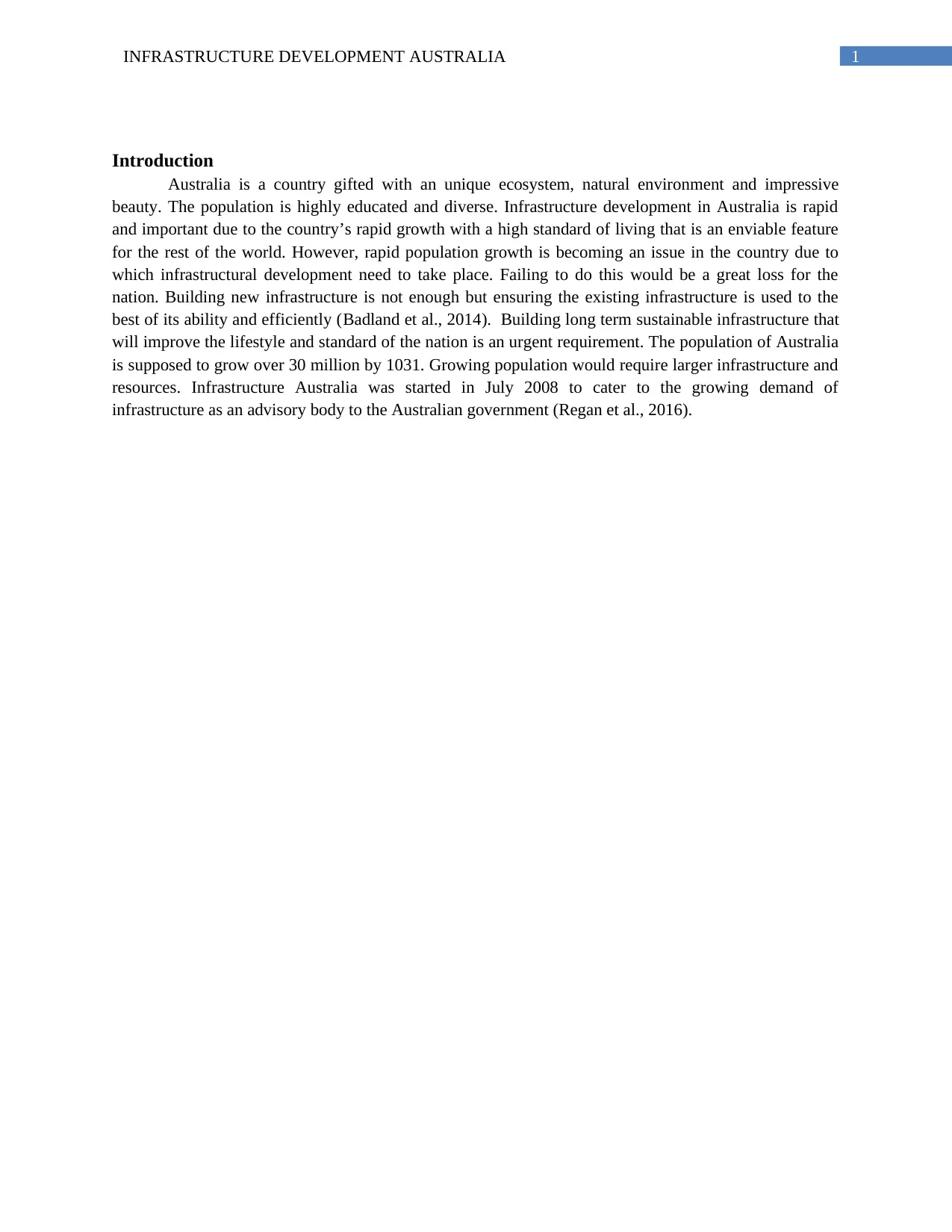
1INFRASTRUCTURE DEVELOPMENT AUSTRALIA
Introduction
Australia is a country gifted with an unique ecosystem, natural environment and impressive
beauty. The population is highly educated and diverse. Infrastructure development in Australia is rapid
and important due to the country’s rapid growth with a high standard of living that is an enviable feature
for the rest of the world. However, rapid population growth is becoming an issue in the country due to
which infrastructural development need to take place. Failing to do this would be a great loss for the
nation. Building new infrastructure is not enough but ensuring the existing infrastructure is used to the
best of its ability and efficiently (Badland et al., 2014). Building long term sustainable infrastructure that
will improve the lifestyle and standard of the nation is an urgent requirement. The population of Australia
is supposed to grow over 30 million by 1031. Growing population would require larger infrastructure and
resources. Infrastructure Australia was started in July 2008 to cater to the growing demand of
infrastructure as an advisory body to the Australian government (Regan et al., 2016).
Introduction
Australia is a country gifted with an unique ecosystem, natural environment and impressive
beauty. The population is highly educated and diverse. Infrastructure development in Australia is rapid
and important due to the country’s rapid growth with a high standard of living that is an enviable feature
for the rest of the world. However, rapid population growth is becoming an issue in the country due to
which infrastructural development need to take place. Failing to do this would be a great loss for the
nation. Building new infrastructure is not enough but ensuring the existing infrastructure is used to the
best of its ability and efficiently (Badland et al., 2014). Building long term sustainable infrastructure that
will improve the lifestyle and standard of the nation is an urgent requirement. The population of Australia
is supposed to grow over 30 million by 1031. Growing population would require larger infrastructure and
resources. Infrastructure Australia was started in July 2008 to cater to the growing demand of
infrastructure as an advisory body to the Australian government (Regan et al., 2016).
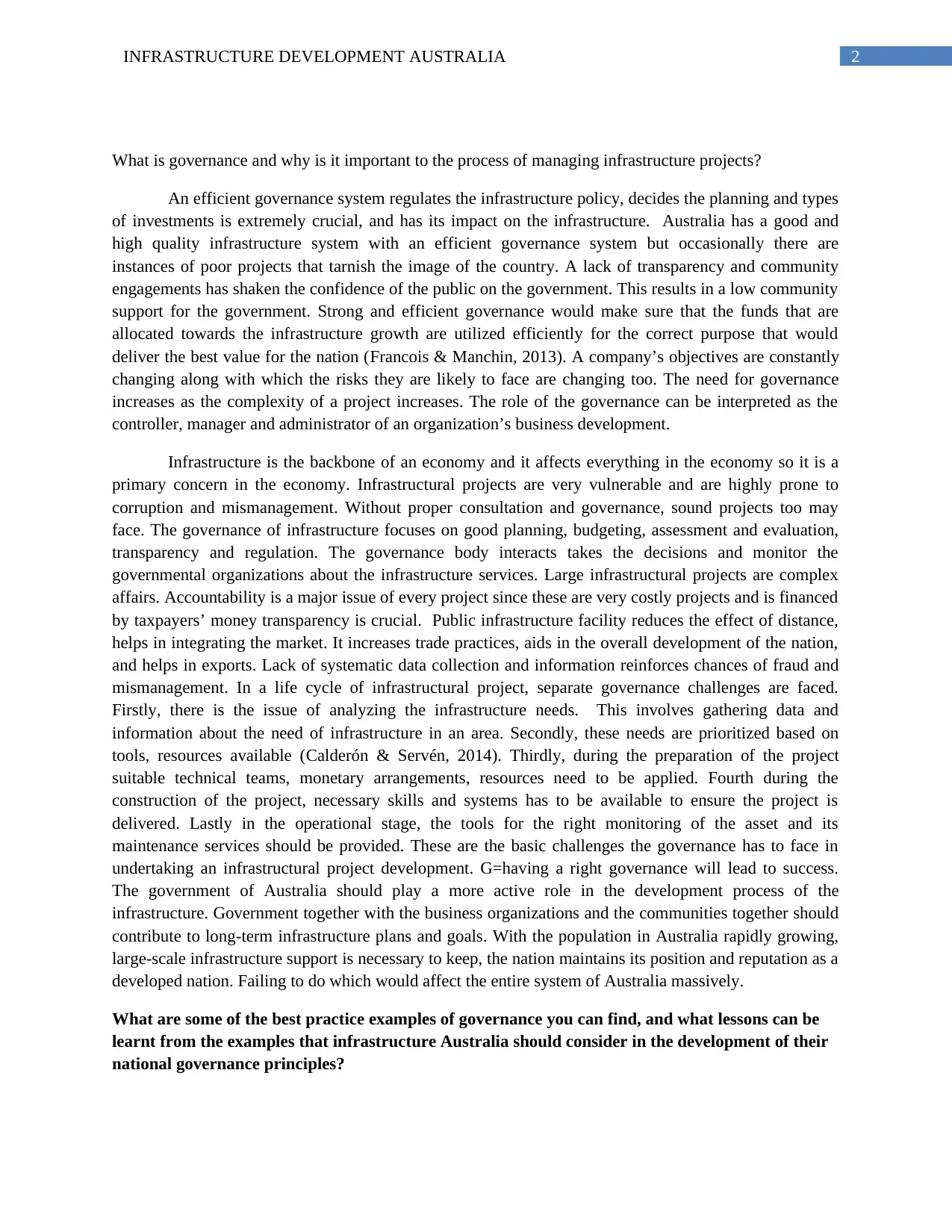
2INFRASTRUCTURE DEVELOPMENT AUSTRALIA
What is governance and why is it important to the process of managing infrastructure projects?
An efficient governance system regulates the infrastructure policy, decides the planning and types
of investments is extremely crucial, and has its impact on the infrastructure. Australia has a good and
high quality infrastructure system with an efficient governance system but occasionally there are
instances of poor projects that tarnish the image of the country. A lack of transparency and community
engagements has shaken the confidence of the public on the government. This results in a low community
support for the government. Strong and efficient governance would make sure that the funds that are
allocated towards the infrastructure growth are utilized efficiently for the correct purpose that would
deliver the best value for the nation (Francois & Manchin, 2013). A company’s objectives are constantly
changing along with which the risks they are likely to face are changing too. The need for governance
increases as the complexity of a project increases. The role of the governance can be interpreted as the
controller, manager and administrator of an organization’s business development.
Infrastructure is the backbone of an economy and it affects everything in the economy so it is a
primary concern in the economy. Infrastructural projects are very vulnerable and are highly prone to
corruption and mismanagement. Without proper consultation and governance, sound projects too may
face. The governance of infrastructure focuses on good planning, budgeting, assessment and evaluation,
transparency and regulation. The governance body interacts takes the decisions and monitor the
governmental organizations about the infrastructure services. Large infrastructural projects are complex
affairs. Accountability is a major issue of every project since these are very costly projects and is financed
by taxpayers’ money transparency is crucial. Public infrastructure facility reduces the effect of distance,
helps in integrating the market. It increases trade practices, aids in the overall development of the nation,
and helps in exports. Lack of systematic data collection and information reinforces chances of fraud and
mismanagement. In a life cycle of infrastructural project, separate governance challenges are faced.
Firstly, there is the issue of analyzing the infrastructure needs. This involves gathering data and
information about the need of infrastructure in an area. Secondly, these needs are prioritized based on
tools, resources available (Calderón & Servén, 2014). Thirdly, during the preparation of the project
suitable technical teams, monetary arrangements, resources need to be applied. Fourth during the
construction of the project, necessary skills and systems has to be available to ensure the project is
delivered. Lastly in the operational stage, the tools for the right monitoring of the asset and its
maintenance services should be provided. These are the basic challenges the governance has to face in
undertaking an infrastructural project development. G=having a right governance will lead to success.
The government of Australia should play a more active role in the development process of the
infrastructure. Government together with the business organizations and the communities together should
contribute to long-term infrastructure plans and goals. With the population in Australia rapidly growing,
large-scale infrastructure support is necessary to keep, the nation maintains its position and reputation as a
developed nation. Failing to do which would affect the entire system of Australia massively.
What are some of the best practice examples of governance you can find, and what lessons can be
learnt from the examples that infrastructure Australia should consider in the development of their
national governance principles?
What is governance and why is it important to the process of managing infrastructure projects?
An efficient governance system regulates the infrastructure policy, decides the planning and types
of investments is extremely crucial, and has its impact on the infrastructure. Australia has a good and
high quality infrastructure system with an efficient governance system but occasionally there are
instances of poor projects that tarnish the image of the country. A lack of transparency and community
engagements has shaken the confidence of the public on the government. This results in a low community
support for the government. Strong and efficient governance would make sure that the funds that are
allocated towards the infrastructure growth are utilized efficiently for the correct purpose that would
deliver the best value for the nation (Francois & Manchin, 2013). A company’s objectives are constantly
changing along with which the risks they are likely to face are changing too. The need for governance
increases as the complexity of a project increases. The role of the governance can be interpreted as the
controller, manager and administrator of an organization’s business development.
Infrastructure is the backbone of an economy and it affects everything in the economy so it is a
primary concern in the economy. Infrastructural projects are very vulnerable and are highly prone to
corruption and mismanagement. Without proper consultation and governance, sound projects too may
face. The governance of infrastructure focuses on good planning, budgeting, assessment and evaluation,
transparency and regulation. The governance body interacts takes the decisions and monitor the
governmental organizations about the infrastructure services. Large infrastructural projects are complex
affairs. Accountability is a major issue of every project since these are very costly projects and is financed
by taxpayers’ money transparency is crucial. Public infrastructure facility reduces the effect of distance,
helps in integrating the market. It increases trade practices, aids in the overall development of the nation,
and helps in exports. Lack of systematic data collection and information reinforces chances of fraud and
mismanagement. In a life cycle of infrastructural project, separate governance challenges are faced.
Firstly, there is the issue of analyzing the infrastructure needs. This involves gathering data and
information about the need of infrastructure in an area. Secondly, these needs are prioritized based on
tools, resources available (Calderón & Servén, 2014). Thirdly, during the preparation of the project
suitable technical teams, monetary arrangements, resources need to be applied. Fourth during the
construction of the project, necessary skills and systems has to be available to ensure the project is
delivered. Lastly in the operational stage, the tools for the right monitoring of the asset and its
maintenance services should be provided. These are the basic challenges the governance has to face in
undertaking an infrastructural project development. G=having a right governance will lead to success.
The government of Australia should play a more active role in the development process of the
infrastructure. Government together with the business organizations and the communities together should
contribute to long-term infrastructure plans and goals. With the population in Australia rapidly growing,
large-scale infrastructure support is necessary to keep, the nation maintains its position and reputation as a
developed nation. Failing to do which would affect the entire system of Australia massively.
What are some of the best practice examples of governance you can find, and what lessons can be
learnt from the examples that infrastructure Australia should consider in the development of their
national governance principles?
⊘ This is a preview!⊘
Do you want full access?
Subscribe today to unlock all pages.

Trusted by 1+ million students worldwide
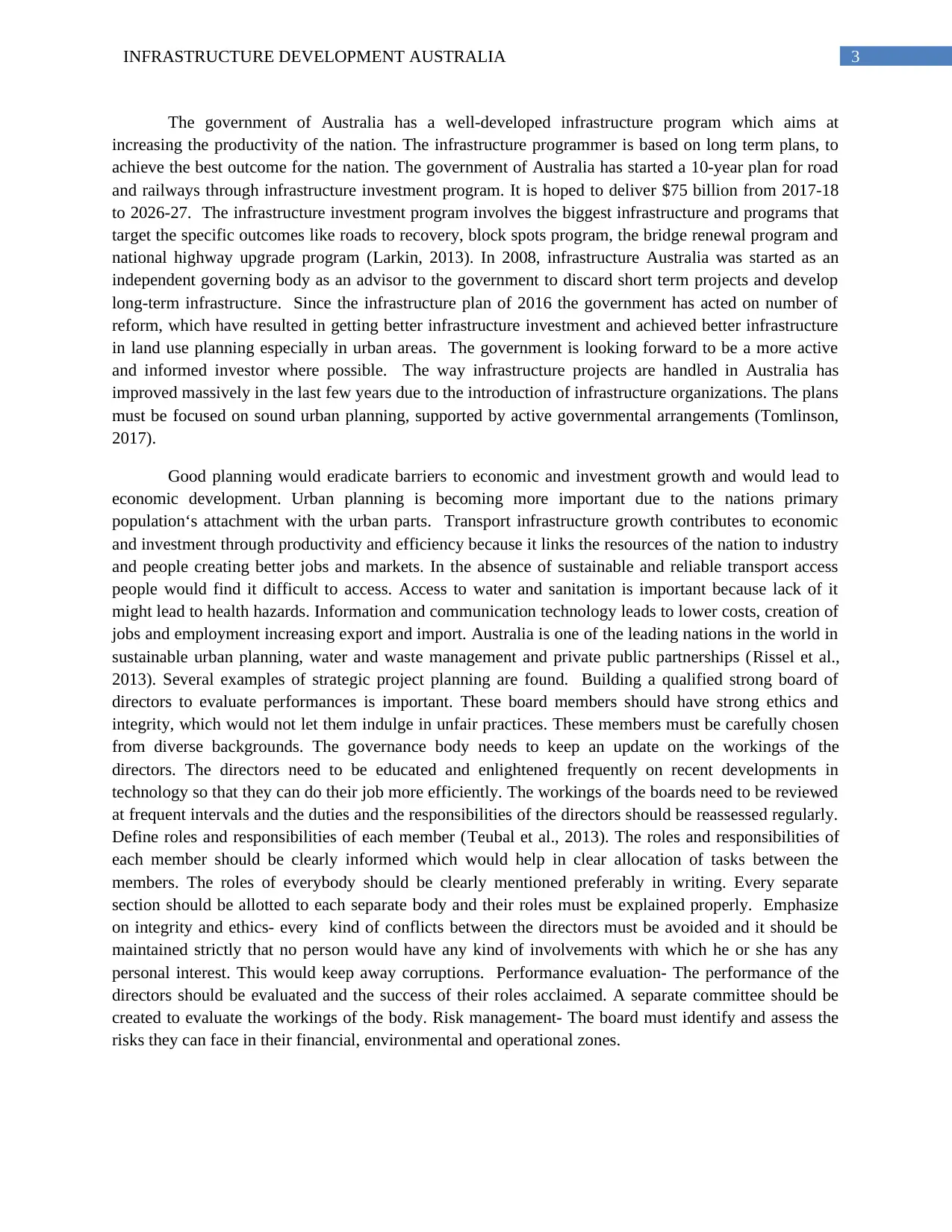
3INFRASTRUCTURE DEVELOPMENT AUSTRALIA
The government of Australia has a well-developed infrastructure program which aims at
increasing the productivity of the nation. The infrastructure programmer is based on long term plans, to
achieve the best outcome for the nation. The government of Australia has started a 10-year plan for road
and railways through infrastructure investment program. It is hoped to deliver $75 billion from 2017-18
to 2026-27. The infrastructure investment program involves the biggest infrastructure and programs that
target the specific outcomes like roads to recovery, block spots program, the bridge renewal program and
national highway upgrade program (Larkin, 2013). In 2008, infrastructure Australia was started as an
independent governing body as an advisor to the government to discard short term projects and develop
long-term infrastructure. Since the infrastructure plan of 2016 the government has acted on number of
reform, which have resulted in getting better infrastructure investment and achieved better infrastructure
in land use planning especially in urban areas. The government is looking forward to be a more active
and informed investor where possible. The way infrastructure projects are handled in Australia has
improved massively in the last few years due to the introduction of infrastructure organizations. The plans
must be focused on sound urban planning, supported by active governmental arrangements (Tomlinson,
2017).
Good planning would eradicate barriers to economic and investment growth and would lead to
economic development. Urban planning is becoming more important due to the nations primary
population‘s attachment with the urban parts. Transport infrastructure growth contributes to economic
and investment through productivity and efficiency because it links the resources of the nation to industry
and people creating better jobs and markets. In the absence of sustainable and reliable transport access
people would find it difficult to access. Access to water and sanitation is important because lack of it
might lead to health hazards. Information and communication technology leads to lower costs, creation of
jobs and employment increasing export and import. Australia is one of the leading nations in the world in
sustainable urban planning, water and waste management and private public partnerships (Rissel et al.,
2013). Several examples of strategic project planning are found. Building a qualified strong board of
directors to evaluate performances is important. These board members should have strong ethics and
integrity, which would not let them indulge in unfair practices. These members must be carefully chosen
from diverse backgrounds. The governance body needs to keep an update on the workings of the
directors. The directors need to be educated and enlightened frequently on recent developments in
technology so that they can do their job more efficiently. The workings of the boards need to be reviewed
at frequent intervals and the duties and the responsibilities of the directors should be reassessed regularly.
Define roles and responsibilities of each member (Teubal et al., 2013). The roles and responsibilities of
each member should be clearly informed which would help in clear allocation of tasks between the
members. The roles of everybody should be clearly mentioned preferably in writing. Every separate
section should be allotted to each separate body and their roles must be explained properly. Emphasize
on integrity and ethics- every kind of conflicts between the directors must be avoided and it should be
maintained strictly that no person would have any kind of involvements with which he or she has any
personal interest. This would keep away corruptions. Performance evaluation- The performance of the
directors should be evaluated and the success of their roles acclaimed. A separate committee should be
created to evaluate the workings of the body. Risk management- The board must identify and assess the
risks they can face in their financial, environmental and operational zones.
The government of Australia has a well-developed infrastructure program which aims at
increasing the productivity of the nation. The infrastructure programmer is based on long term plans, to
achieve the best outcome for the nation. The government of Australia has started a 10-year plan for road
and railways through infrastructure investment program. It is hoped to deliver $75 billion from 2017-18
to 2026-27. The infrastructure investment program involves the biggest infrastructure and programs that
target the specific outcomes like roads to recovery, block spots program, the bridge renewal program and
national highway upgrade program (Larkin, 2013). In 2008, infrastructure Australia was started as an
independent governing body as an advisor to the government to discard short term projects and develop
long-term infrastructure. Since the infrastructure plan of 2016 the government has acted on number of
reform, which have resulted in getting better infrastructure investment and achieved better infrastructure
in land use planning especially in urban areas. The government is looking forward to be a more active
and informed investor where possible. The way infrastructure projects are handled in Australia has
improved massively in the last few years due to the introduction of infrastructure organizations. The plans
must be focused on sound urban planning, supported by active governmental arrangements (Tomlinson,
2017).
Good planning would eradicate barriers to economic and investment growth and would lead to
economic development. Urban planning is becoming more important due to the nations primary
population‘s attachment with the urban parts. Transport infrastructure growth contributes to economic
and investment through productivity and efficiency because it links the resources of the nation to industry
and people creating better jobs and markets. In the absence of sustainable and reliable transport access
people would find it difficult to access. Access to water and sanitation is important because lack of it
might lead to health hazards. Information and communication technology leads to lower costs, creation of
jobs and employment increasing export and import. Australia is one of the leading nations in the world in
sustainable urban planning, water and waste management and private public partnerships (Rissel et al.,
2013). Several examples of strategic project planning are found. Building a qualified strong board of
directors to evaluate performances is important. These board members should have strong ethics and
integrity, which would not let them indulge in unfair practices. These members must be carefully chosen
from diverse backgrounds. The governance body needs to keep an update on the workings of the
directors. The directors need to be educated and enlightened frequently on recent developments in
technology so that they can do their job more efficiently. The workings of the boards need to be reviewed
at frequent intervals and the duties and the responsibilities of the directors should be reassessed regularly.
Define roles and responsibilities of each member (Teubal et al., 2013). The roles and responsibilities of
each member should be clearly informed which would help in clear allocation of tasks between the
members. The roles of everybody should be clearly mentioned preferably in writing. Every separate
section should be allotted to each separate body and their roles must be explained properly. Emphasize
on integrity and ethics- every kind of conflicts between the directors must be avoided and it should be
maintained strictly that no person would have any kind of involvements with which he or she has any
personal interest. This would keep away corruptions. Performance evaluation- The performance of the
directors should be evaluated and the success of their roles acclaimed. A separate committee should be
created to evaluate the workings of the body. Risk management- The board must identify and assess the
risks they can face in their financial, environmental and operational zones.
Paraphrase This Document
Need a fresh take? Get an instant paraphrase of this document with our AI Paraphraser
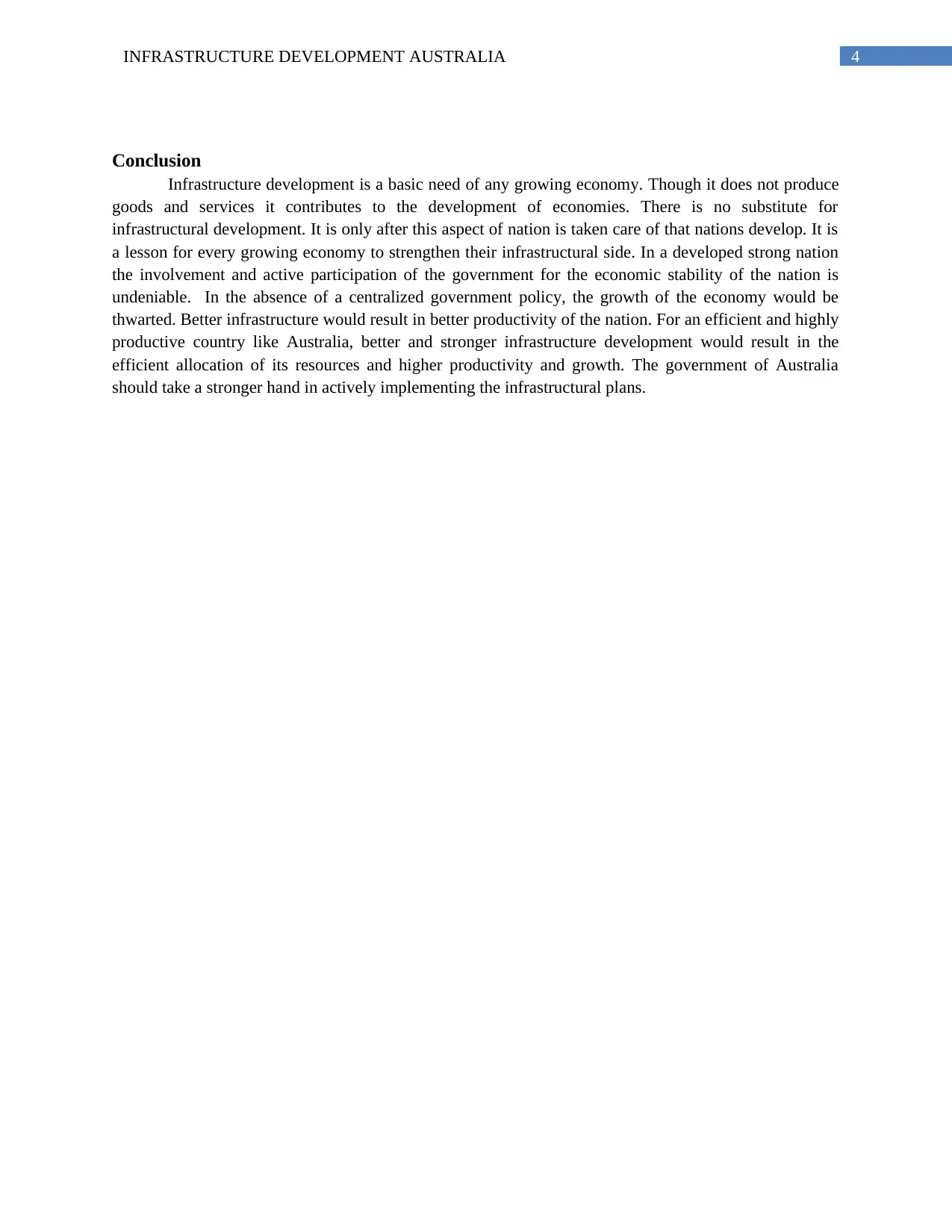
4INFRASTRUCTURE DEVELOPMENT AUSTRALIA
Conclusion
Infrastructure development is a basic need of any growing economy. Though it does not produce
goods and services it contributes to the development of economies. There is no substitute for
infrastructural development. It is only after this aspect of nation is taken care of that nations develop. It is
a lesson for every growing economy to strengthen their infrastructural side. In a developed strong nation
the involvement and active participation of the government for the economic stability of the nation is
undeniable. In the absence of a centralized government policy, the growth of the economy would be
thwarted. Better infrastructure would result in better productivity of the nation. For an efficient and highly
productive country like Australia, better and stronger infrastructure development would result in the
efficient allocation of its resources and higher productivity and growth. The government of Australia
should take a stronger hand in actively implementing the infrastructural plans.
Conclusion
Infrastructure development is a basic need of any growing economy. Though it does not produce
goods and services it contributes to the development of economies. There is no substitute for
infrastructural development. It is only after this aspect of nation is taken care of that nations develop. It is
a lesson for every growing economy to strengthen their infrastructural side. In a developed strong nation
the involvement and active participation of the government for the economic stability of the nation is
undeniable. In the absence of a centralized government policy, the growth of the economy would be
thwarted. Better infrastructure would result in better productivity of the nation. For an efficient and highly
productive country like Australia, better and stronger infrastructure development would result in the
efficient allocation of its resources and higher productivity and growth. The government of Australia
should take a stronger hand in actively implementing the infrastructural plans.
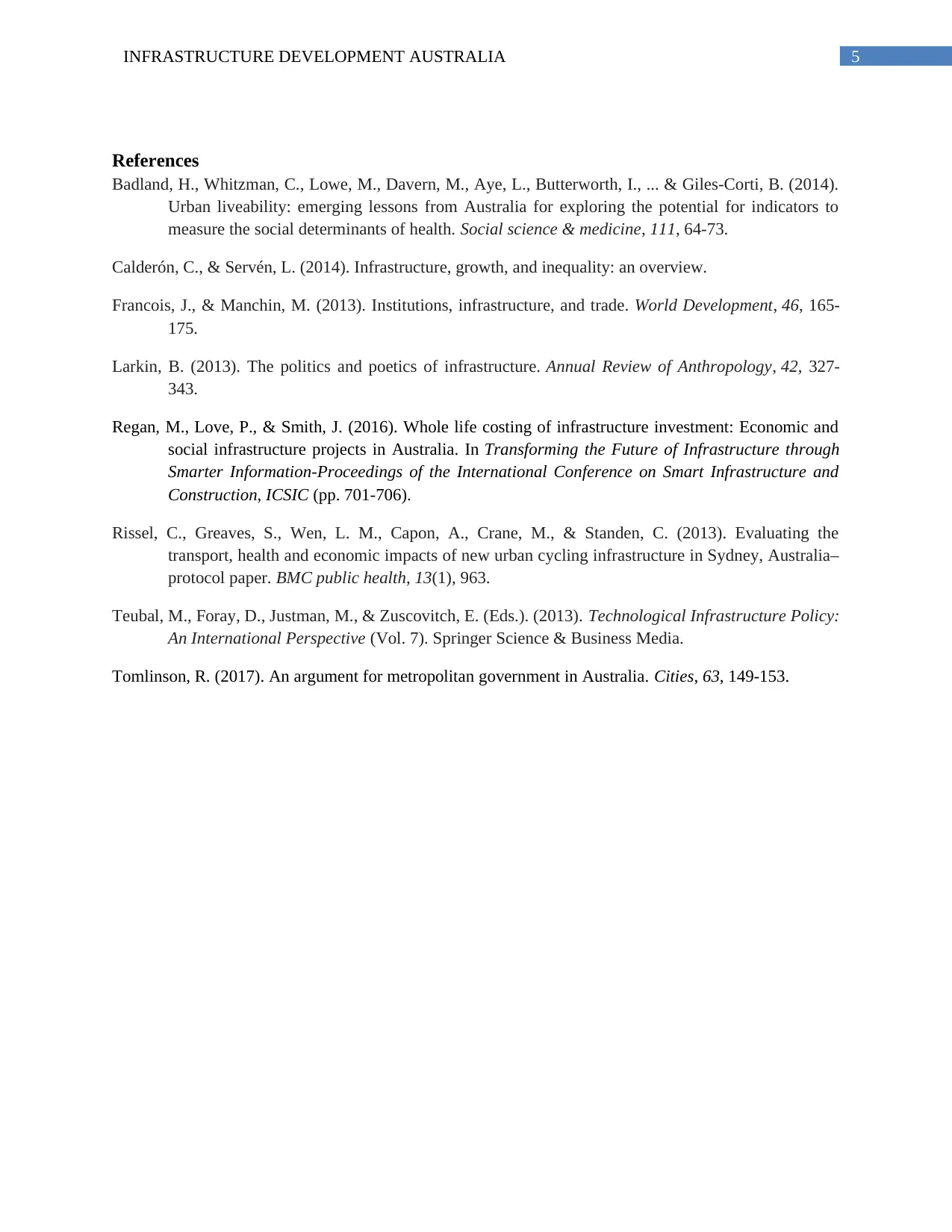
5INFRASTRUCTURE DEVELOPMENT AUSTRALIA
References
Badland, H., Whitzman, C., Lowe, M., Davern, M., Aye, L., Butterworth, I., ... & Giles-Corti, B. (2014).
Urban liveability: emerging lessons from Australia for exploring the potential for indicators to
measure the social determinants of health. Social science & medicine, 111, 64-73.
Calderón, C., & Servén, L. (2014). Infrastructure, growth, and inequality: an overview.
Francois, J., & Manchin, M. (2013). Institutions, infrastructure, and trade. World Development, 46, 165-
175.
Larkin, B. (2013). The politics and poetics of infrastructure. Annual Review of Anthropology, 42, 327-
343.
Regan, M., Love, P., & Smith, J. (2016). Whole life costing of infrastructure investment: Economic and
social infrastructure projects in Australia. In Transforming the Future of Infrastructure through
Smarter Information-Proceedings of the International Conference on Smart Infrastructure and
Construction, ICSIC (pp. 701-706).
Rissel, C., Greaves, S., Wen, L. M., Capon, A., Crane, M., & Standen, C. (2013). Evaluating the
transport, health and economic impacts of new urban cycling infrastructure in Sydney, Australia–
protocol paper. BMC public health, 13(1), 963.
Teubal, M., Foray, D., Justman, M., & Zuscovitch, E. (Eds.). (2013). Technological Infrastructure Policy:
An International Perspective (Vol. 7). Springer Science & Business Media.
Tomlinson, R. (2017). An argument for metropolitan government in Australia. Cities, 63, 149-153.
References
Badland, H., Whitzman, C., Lowe, M., Davern, M., Aye, L., Butterworth, I., ... & Giles-Corti, B. (2014).
Urban liveability: emerging lessons from Australia for exploring the potential for indicators to
measure the social determinants of health. Social science & medicine, 111, 64-73.
Calderón, C., & Servén, L. (2014). Infrastructure, growth, and inequality: an overview.
Francois, J., & Manchin, M. (2013). Institutions, infrastructure, and trade. World Development, 46, 165-
175.
Larkin, B. (2013). The politics and poetics of infrastructure. Annual Review of Anthropology, 42, 327-
343.
Regan, M., Love, P., & Smith, J. (2016). Whole life costing of infrastructure investment: Economic and
social infrastructure projects in Australia. In Transforming the Future of Infrastructure through
Smarter Information-Proceedings of the International Conference on Smart Infrastructure and
Construction, ICSIC (pp. 701-706).
Rissel, C., Greaves, S., Wen, L. M., Capon, A., Crane, M., & Standen, C. (2013). Evaluating the
transport, health and economic impacts of new urban cycling infrastructure in Sydney, Australia–
protocol paper. BMC public health, 13(1), 963.
Teubal, M., Foray, D., Justman, M., & Zuscovitch, E. (Eds.). (2013). Technological Infrastructure Policy:
An International Perspective (Vol. 7). Springer Science & Business Media.
Tomlinson, R. (2017). An argument for metropolitan government in Australia. Cities, 63, 149-153.
⊘ This is a preview!⊘
Do you want full access?
Subscribe today to unlock all pages.

Trusted by 1+ million students worldwide
1 out of 6
Related Documents
Your All-in-One AI-Powered Toolkit for Academic Success.
+13062052269
info@desklib.com
Available 24*7 on WhatsApp / Email
![[object Object]](/_next/static/media/star-bottom.7253800d.svg)
Unlock your academic potential
Copyright © 2020–2025 A2Z Services. All Rights Reserved. Developed and managed by ZUCOL.





